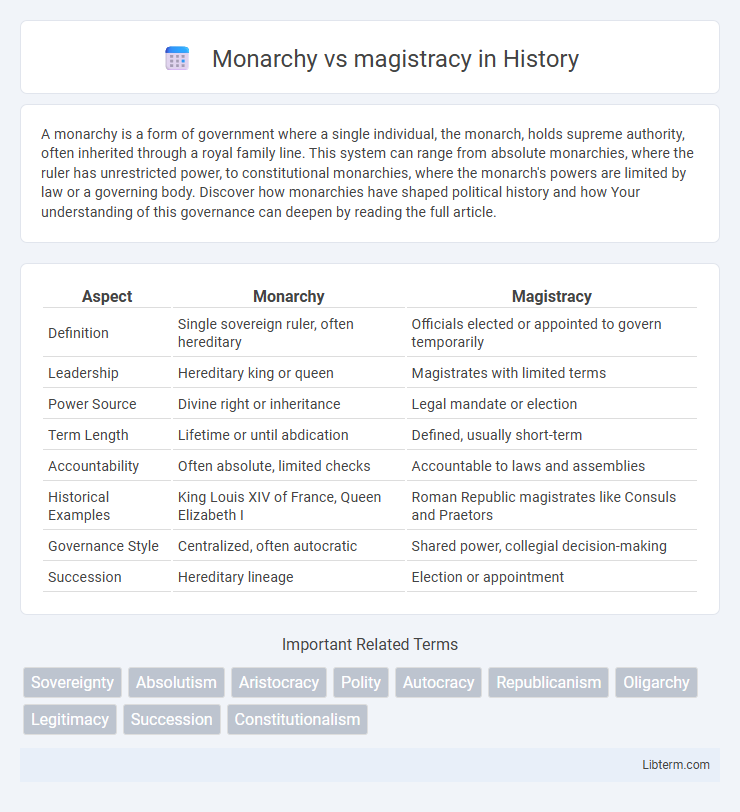A monarchy is a form of government where a single individual, the monarch, holds supreme authority, often inherited through a royal family line. This system can range from absolute monarchies, where the ruler has unrestricted power, to constitutional monarchies, where the monarch's powers are limited by law or a governing body. Discover how monarchies have shaped political history and how Your understanding of this governance can deepen by reading the full article.
Table of Comparison
| Aspect | Monarchy | Magistracy |
|---|---|---|
| Definition | Single sovereign ruler, often hereditary | Officials elected or appointed to govern temporarily |
| Leadership | Hereditary king or queen | Magistrates with limited terms |
| Power Source | Divine right or inheritance | Legal mandate or election |
| Term Length | Lifetime or until abdication | Defined, usually short-term |
| Accountability | Often absolute, limited checks | Accountable to laws and assemblies |
| Historical Examples | King Louis XIV of France, Queen Elizabeth I | Roman Republic magistrates like Consuls and Praetors |
| Governance Style | Centralized, often autocratic | Shared power, collegial decision-making |
| Succession | Hereditary lineage | Election or appointment |
Historical Origins of Monarchy and Magistracy
The historical origins of monarchy trace back to ancient civilizations like Mesopotamia and Egypt, where centralized rulers such as pharaohs and kings held supreme power based on divine right and hereditary succession. In contrast, magistracy emerged prominently in classical Athens and the Roman Republic, characterized by elected officials or magistrates with limited terms, emphasizing accountability and civic duty. These distinct systems reflect contrasting foundations: monarchy's concentration of authority versus magistracy's distribution of power within early political structures.
Core Principles of Monarchical Rule
Monarchical rule centers on the concentration of sovereign power in a single ruler, often justified by divine right or hereditary succession, emphasizing stability and continuity. This system prioritizes centralized authority, where the monarch's decisions are binding and serve as the ultimate source of law and governance. The core principles include legitimacy through lineage or appointment, unchallenged executive power, and the maintenance of order through hierarchical command.
Magistracy: Definition and Key Features
Magistracy refers to a system of government where officials, known as magistrates, hold executive, judicial, and administrative powers, typically elected or appointed for fixed terms rather than inheriting authority. Key features of magistracy include the division of power among multiple magistrates to prevent concentration, accountability through legal and electoral mechanisms, and a focus on upholding laws and public order in a structured legal framework. Unlike monarchy, magistracy emphasizes collective governance and rule of law over singular, hereditary rule.
Power Distribution in Monarchies vs Magistracies
In monarchies, power is centralized under a single ruler, such as a king or queen, who holds supreme authority often inherited through dynastic succession. Magistracies distribute power among elected or appointed officials, emphasizing checks and balances to prevent autocratic rule. This decentralized structure promotes accountability and limits the concentration of power typically seen in monarchies.
Succession and Leadership Selection
Monarchy ensures a hereditary succession, where leadership is passed through familial bloodlines, typically from parent to offspring, establishing a clear, predetermined lineage. In contrast, magistracy relies on elective or merit-based selection processes, with leaders chosen by assemblies or councils for limited terms rather than inheriting power. This difference directly impacts political stability and governance, as monarchies often provide continuity, whereas magistracies emphasize accountability and rotational leadership.
Legal Authority and Governance Structure
Monarchy vests legal authority predominantly in a hereditary sovereign who holds centralized power, often guided by established traditions and royal decrees. Magistracy distributes legal authority among elected or appointed officials with jurisdiction grounded in codified laws and institutional frameworks. Governance under monarchy tends toward autocratic rule, whereas magistracy emphasizes rule of law and bureaucratic administration.
Public Participation and Representation
Monarchy centralizes power in a single ruler, limiting public participation and often offering minimal avenues for citizen representation in decision-making processes. Magistracy, commonly found in republics and democratic systems, emphasizes elected or appointed officials who represent the public's interests, enabling broader engagement and accountability. This structure fosters greater public involvement through voting, petitions, and civic duties, strengthening the link between governance and the populace.
Stability and Adaptability in Both Systems
Monarchy offers stability through centralized authority and clear succession, minimizing power struggles and ensuring consistent governance, while often struggling with adaptability due to resistance from entrenched interests. Magistracy promotes adaptability by distributing power among elected officials with limited terms, enabling flexible responses to societal changes, yet it may experience instability from frequent leadership transitions and political competition. Balancing stability and adaptability requires integrating monarchic continuity with magistratorial responsiveness to sustain effective governance.
Monarchy and Magistracy in Modern Societies
Monarchy in modern societies often serves as a symbolic institution with limited political power, retaining cultural and national identity significance through hereditary leadership. Magistracy, by contrast, functions as an essential component of contemporary governance, emphasizing rule of law and administrative authority exercised by elected or appointed officials. The coexistence of both systems reflects varied approaches to authority, where monarchy provides continuity and tradition while magistracy ensures accountability and legal order.
Comparative Advantages and Disadvantages
Monarchy offers centralized authority enabling swift decision-making and long-term policy consistency, but risks authoritarianism and lack of accountability. Magistracy provides a structured system with checks and balances, promoting rule of law and limiting power abuse, yet it can suffer from bureaucracy and slower governance processes. Both systems present trade-offs between efficiency, control, and democratic accountability.
Monarchy Infographic

 libterm.com
libterm.com